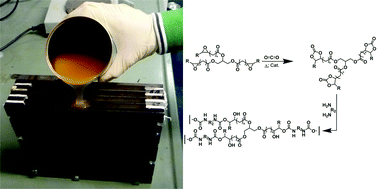Soy- and linseed oil-based polyurethanes were synthesized by curing carbonated soybean and linseed oils with different diamines.

Macromolecular Chemistry, Germany, have developed a non-isocyante route to soy- and linseed oil-based polyurethanes. The route involved conversion of the epoxidised seed oils with carbon dioxide to form cyclic carbonates catalysed by tetra-butylammonium bromide and silica supported 4-pyrrolidinopyridium iodide. The catalysts could be easily recovered without needing traditional solvent extraction. The resulting carbonates were then cured with various amines to give the polyurethanes.
As well as avoiding the use of toxic chemicals, this route also led to some polkyurethanes with increased glass transition temperatures and improved stiffness. To find out more, just click on the article link below. This article is currently free to access until the 15th February 2012!
Linseed and soybean oil-based polyurethanes prepared viathe non-isocyanate route and catalytic carbon dioxide conversion, Moritz Bähr and Rolf Mülhaupt, Green Chem., 2012, DOI: 10.1039/C2GC16230J
You may also find these articles of interest – free to access until the 15th February 2012 too! So why not take a look…
Biorenewable polyethylene terephthalate mimics derived from lignin and acetic acid, Laurent Mialon, Alexander G. Pemba and Stephen A. Miller, Green Chem., 2010, 12, 1704-1706
Vegetable oil-based polymeric materials: synthesis, properties, and applications, Ying Xia and Richard C. Larock, Green Chem., 2010, 12, 1893-1909
Keep up-to-date with the latest content in Green Chemistry by registering for our free table of contents alerts!










